If you’re here, you’ve probably found something strange growing at home and you’re thinking it might be mold. Well, you’re in the right place!
First things first, don’t panic! But don’t let it stay there either. You’re on the right path. It is impossible to prevent mold from appearing at all. Yeah, you can try by reducing the causes but it’s not your fault if they keep coming back.
Now, we are going to see a little more in depth each type of mold but there’s one thing they have all in common (and that’s for sure!)… They loooove humid places. A place with moisture is a place with mold (or at least with a high probability of having it!).
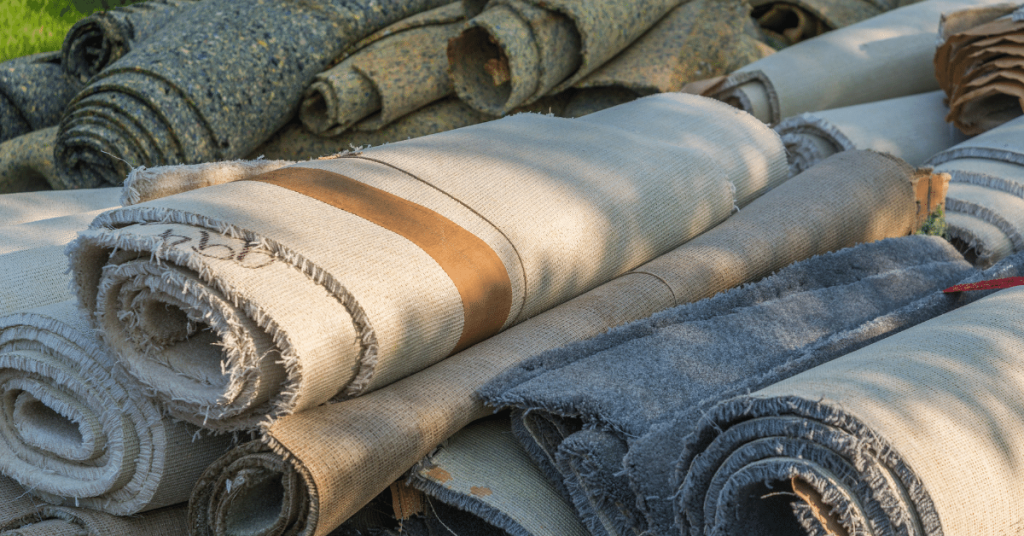
12 Most Common types of Mold
As you already know, we are going to take a look at the 12 most common types of mold that can appear in any home.
To make it easier, I’ve separated them in 3 levels based on how dangerous they can be to our health: low, moderate and high. Very simple.
Danger level: Low
1. Alternaria
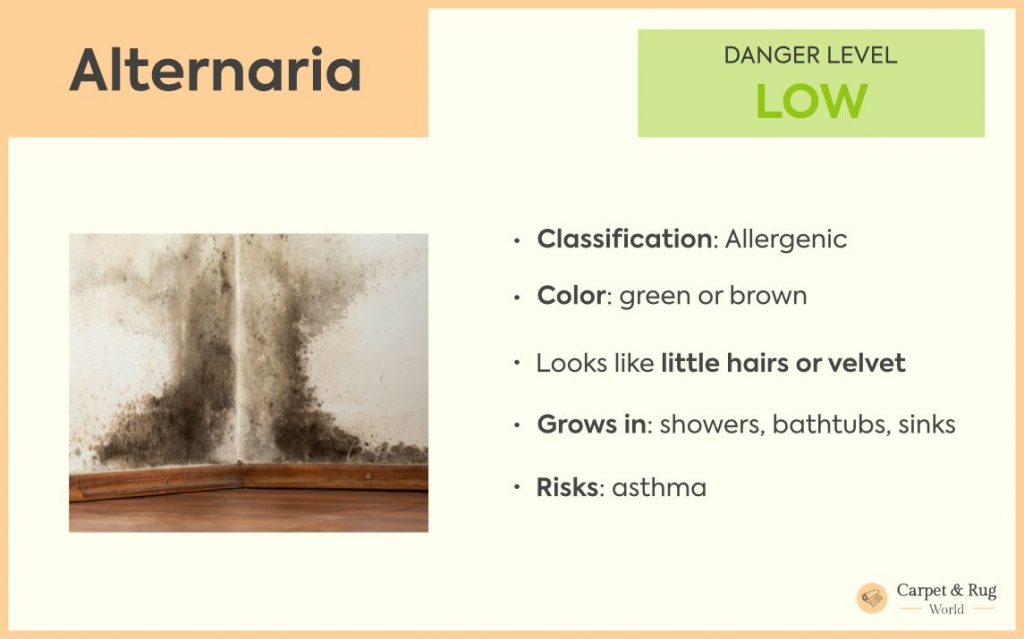
This one’s the most common of all allergenic molds. They love damp places. It spreads rapidly so beware! If do nothing, suddenly you’ll see yourself surrounded by lots of it!
Type: Allergenic
Color: Brown and dark green
Look: Velvet or “little hair”
They love: They appear wherever there is a water damage such as bathtubs, sinks and showers.
Risks: Asthma, allergic reactions such as watery and itchy eyes, cough…
2. Aureobasidium

Be careful not to touch it with you bare skin as it could potentially cause you dermatitis. It isn’t to dangerous but it’s important to have it removed as it could also break into the air.
Type: Allergenic
Color: Pink, black and brown
Look: Moist paint
They love: They love to hide behind wallpaper and painted or wooden surfaces.
Risks: Skin, nail and eye infections.
3. Trichoderma
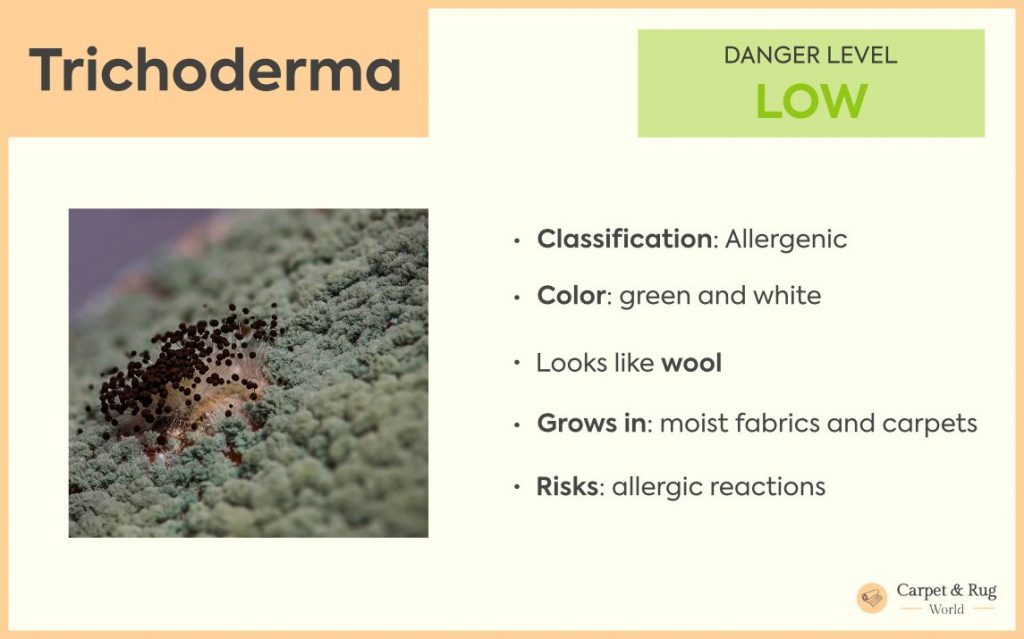
They love to be where condensation is, so you may find them in your HVAC conducts and A/C filters also. They grow rapidly and form colonies.
We’ve considered that it’s not dangerous normally but it could cause great damage as it destroys almost everything they grow on, such as wood, paper or textiles. They could harm badly the structures of your house if you catch it too late.
Type: Allergenic
Color: Green and white
Look: It looks like wool
They love: You can find it in wet or moist carpets, fabrics, wallpaper, etc.
Risks: “Most trichoderma molds are non-pathogenic,” AerIndustries states, but other types produce mycotoxins, which can cause sinusitis, allergic reactions, and other health problems
Danger level: Moderate
4. Aspergillus

This is the most common mold found in all US homes.
Type: Allergenic, but could be toxic
Color: They can have many different colors
Look: The look like spores and form big layers on the walls
Risks: It could lead to allergic reactions and respiratory infections. And some of these species may produce aflatoxins, which is a deadly carcinogen.
5. Chaetomium

It’ll be easy for you to detect as it usually starts spreading a musty smell. And it grows chronically in moist conditions, so be aware to remove them completely if you want to stop them from appearing again.
Type: It could potentially be toxic
Color: Start being white but with time changes to grey, brown and finally black.
Look: It looks similar to cotton.
They love: You can find it in water-damaged homes (especially in leaking roofs, pipes, damp basements, etc.)
Risks: Nail and skin infections. In some cases it can be dangerous to people who have compromised immune systems.
6. Cladosporium
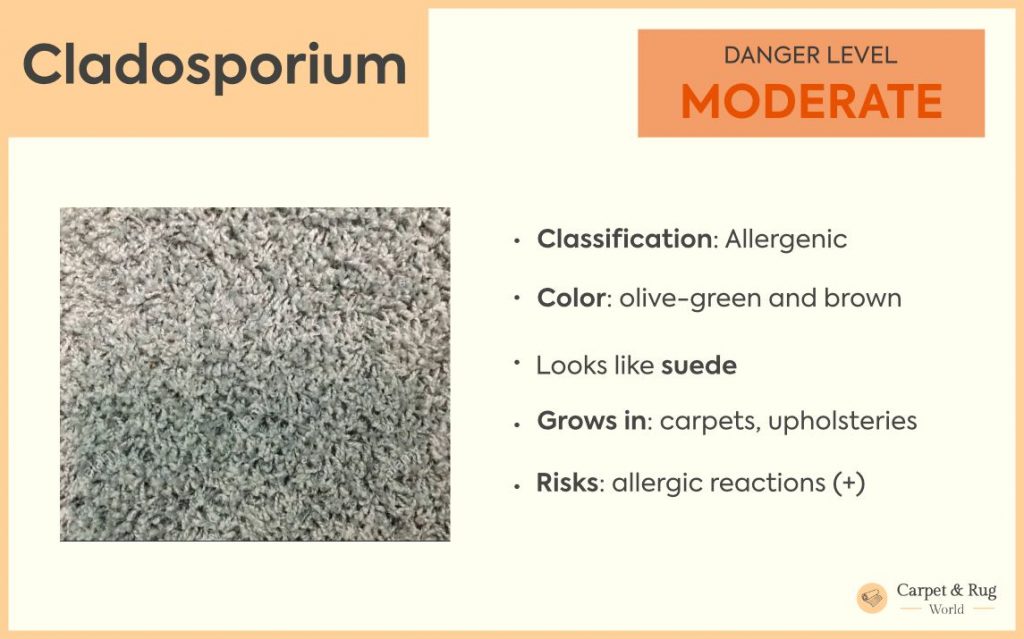
This guy doesn’t care about the weather. It will appear on cold and warm conditions. But one thing’s for sure… they love ot hide inside cupboards or under floorboards.
It shouldn’t be ouched directly as it could cause skin and lung irritation.
Type: Allergenic
Color: Green and brown
Look: Very similar to suede
They love: You’ll find it in carpets, upholsteries, fabrics, etc.
Risks: It can cause respiratory problems and allergic reaction in eyes, skin, throat and nose.
7. Mucor
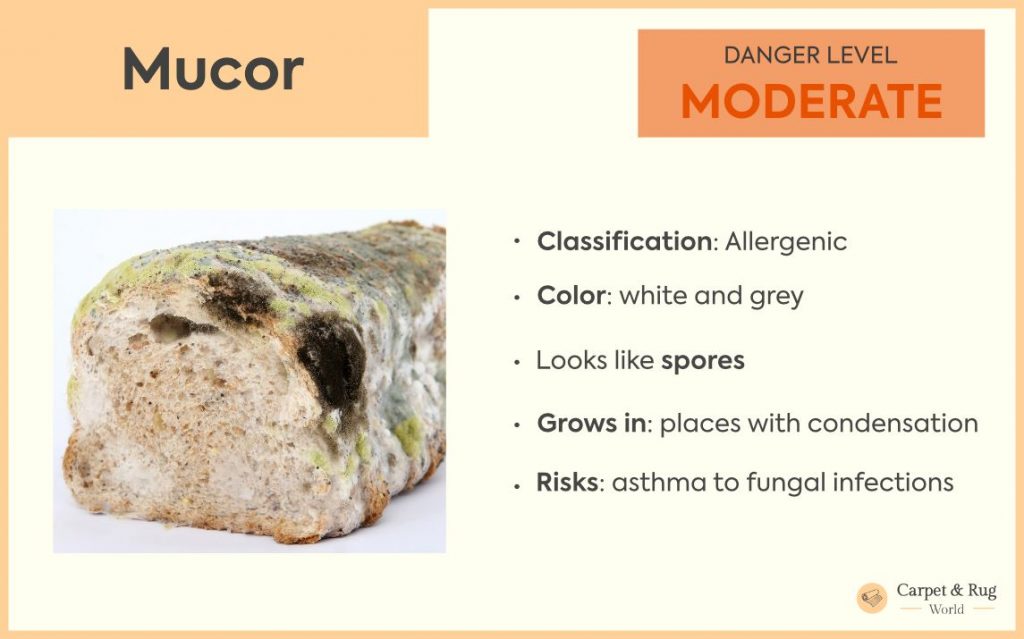
This one grows quickly. And it might seem harmless but don’t think about touching it!
If you think you have mucor at home call an expert inmediately to have it removed.
Type: Allergenic
Color: Grey and white
Look: It looks just like spores
They love: Moisture and condensation is their dream-land, so anywhere near an A/C unit, HVAC conduct or a damp carpet that’s where you’ll find it.
Risks: It can start with asthma symptoms but you could end up with a fungal infection in your eyes, lungs, brain, nose and sinuses.
8. Penicillium

You may be wondering…. is it the same as penicillin? Well, yes and no. This is what it is used to create it.
Type: Allergenic
Color: Blue and green
Look: It has a velvet texture
They love: Damp and moist places such as carpets, mattresses, wallpaper, etc.
Risks: The spores can easily spread thoughout the air in your home. And this can cause respiratory problems, such as asthma, pulmonary inflammation and potentially chronic sinusitis.
Danger level: High
If you have this at home, keep everyone away as it is extremely harmful and have it removed inmediately by professionals.
9. Acremonium
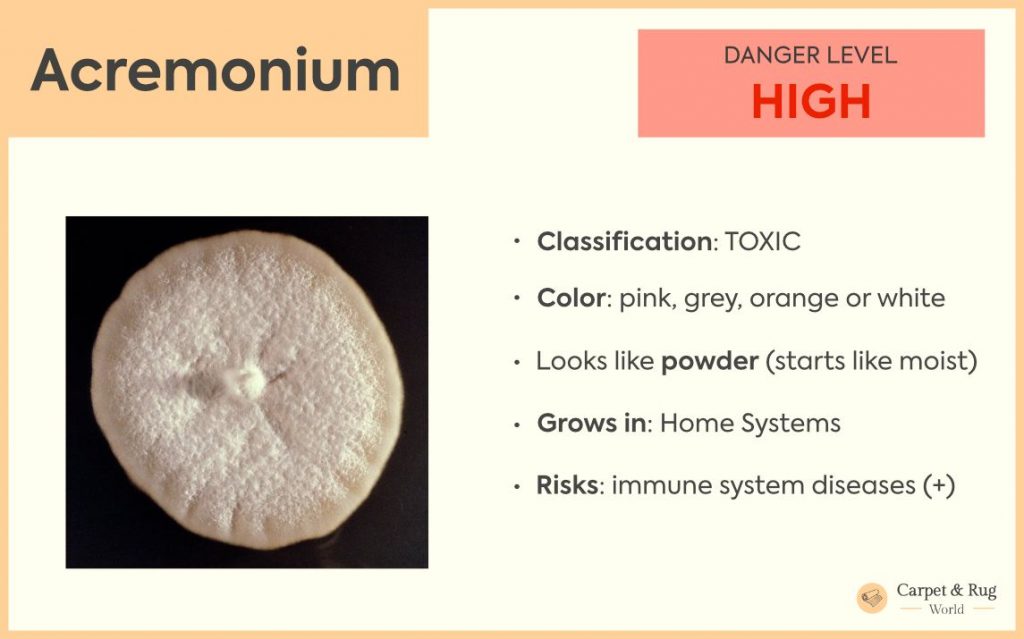
If you have this at home, keep everyone away as it is extremely harmful and have it removed inmediately by professionals.
Type: Toxic
Color: Pink, orange, grey and white
Look: It looks like a powder but starts as a moist substance.
They love: Home systems like humidifiers, drain pans or windows are their favourite place to be. It can also grow right next to other types of mold we haven’t seen yet such as, strachybotrys (black mold) and others.
Risks: It is very is dangerous. It can cause immune system diseases, impaired brain function and bone marrow diseases. It can also create dangerous problems in homes.
10. Fusarium
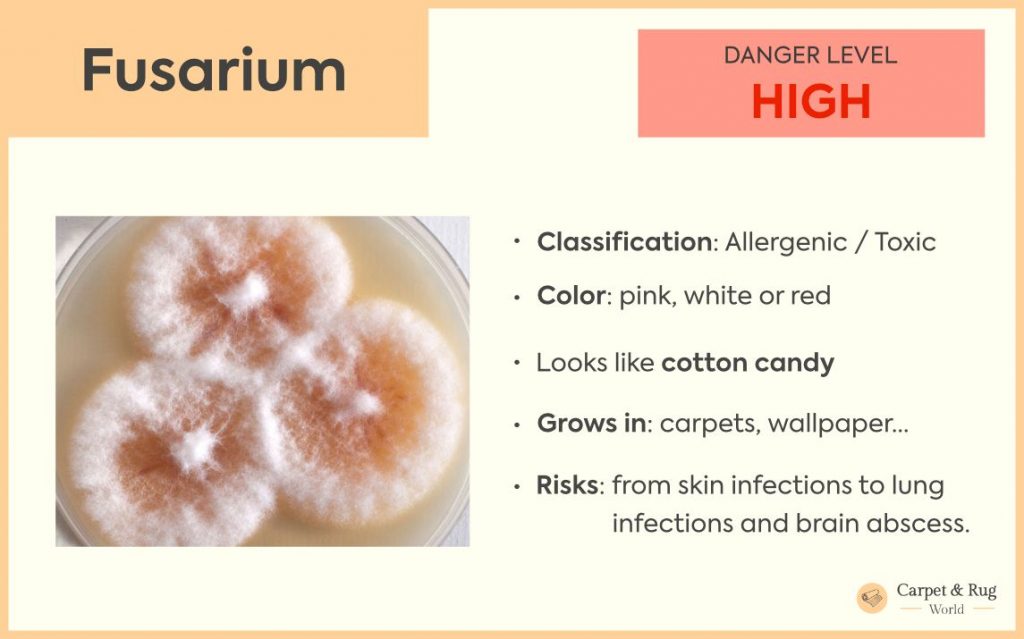
Did you know they naturally grow on food? Well, you don’t want them in yours!
Type: Allergenic and Toxic
Color: Pink, red and white
Look: It’s just like cotton candy
They love: They live in carpets, wallpapers, etc.
Risks: They go from skin infections to bone a and lung infections, brain abscess and allergic reactions such as runny nose, sore throat, itchy eyes, sneezing, etc. An in the end, it could also damage your nervous systems, leading to potential hemorrhage and internal bleeding.
11. Stachybotrys (AKA Black Mold)
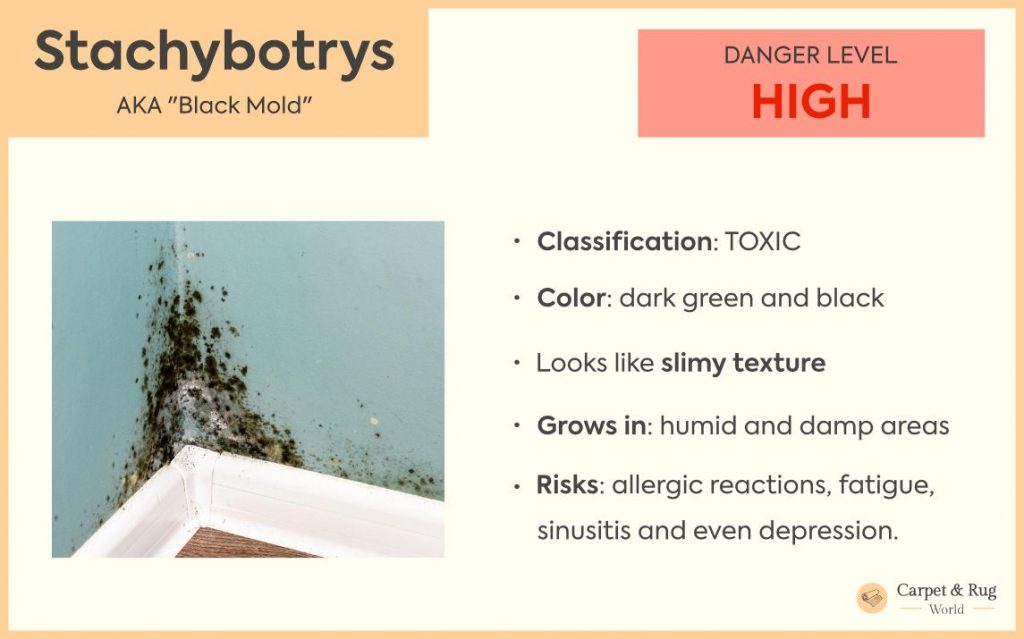
This type of mold can cause neurological and pulmonary problems in your kids. So beware! If you think you might be growing black mold at home, call a remediation professional asap to have it removed.
Type: Toxic
Color: Dark green or black
Look: It has a slimy texture
They love: If you have a place at home that has been wet or humid for days, then watch out fot this “bad boy”.
Risks: They can provoke severe health troubles (i.e. fatigue, breathing problems, sinusitis, and depression). It is also known to have caused neurological problems and pulmonary bleeding, especially in kids.
12. Ulocladium

And last but not least! This type of mold could be easily confused with others which aren’t that dangerous.
If you have it at home, then you probably have a water damage somewhere.
Type: Could be allergenic and toxic
Color: Black
Look: Black in color, typically
They love: You can find it in high condesations places such as bathrooms, basements, kitchens and windows.
Risks: You could suffer from high fever, asthma symptoms and skin infections.
A great solution: Air purifiers
Now that we’ve covered all the types of mold that could appear at your house, let’s talk about prevention.
If your house suffers from high temperatures and high humidity then mold will find it’s way in. For them, that’s paradise! And since we’ve seen how dangerous they can be, it’s time to take action.
First, if there’s mold in your home, call a professional inmediately. This way it won’t be able to spread much more. Once they’ve solved the problem, to avoid having this enemies back in, we recommend you to buy an Air Purifier.
Air Purifiers work the following way: they trap the mold spores floating in the air of your home before they land and spread all over your carpets and walls.
If you’re going to buy it make sure it includes a HEPA (high-efficiency particulate air) filter.
Here you have some options:
Conclusion
And… that’s a wrap!
I know how worrying it can be to have something strange-looking crawling up your beautiful walls and carpets… trut me, I know! But once decipher what’s that thing you have, you can tackle the problem the right way.
If you have mold on the a carpet at home, don’t worry. We’ve got you covered with this article were you’ll find all the information you need to save your carpet from getting all ruined.
